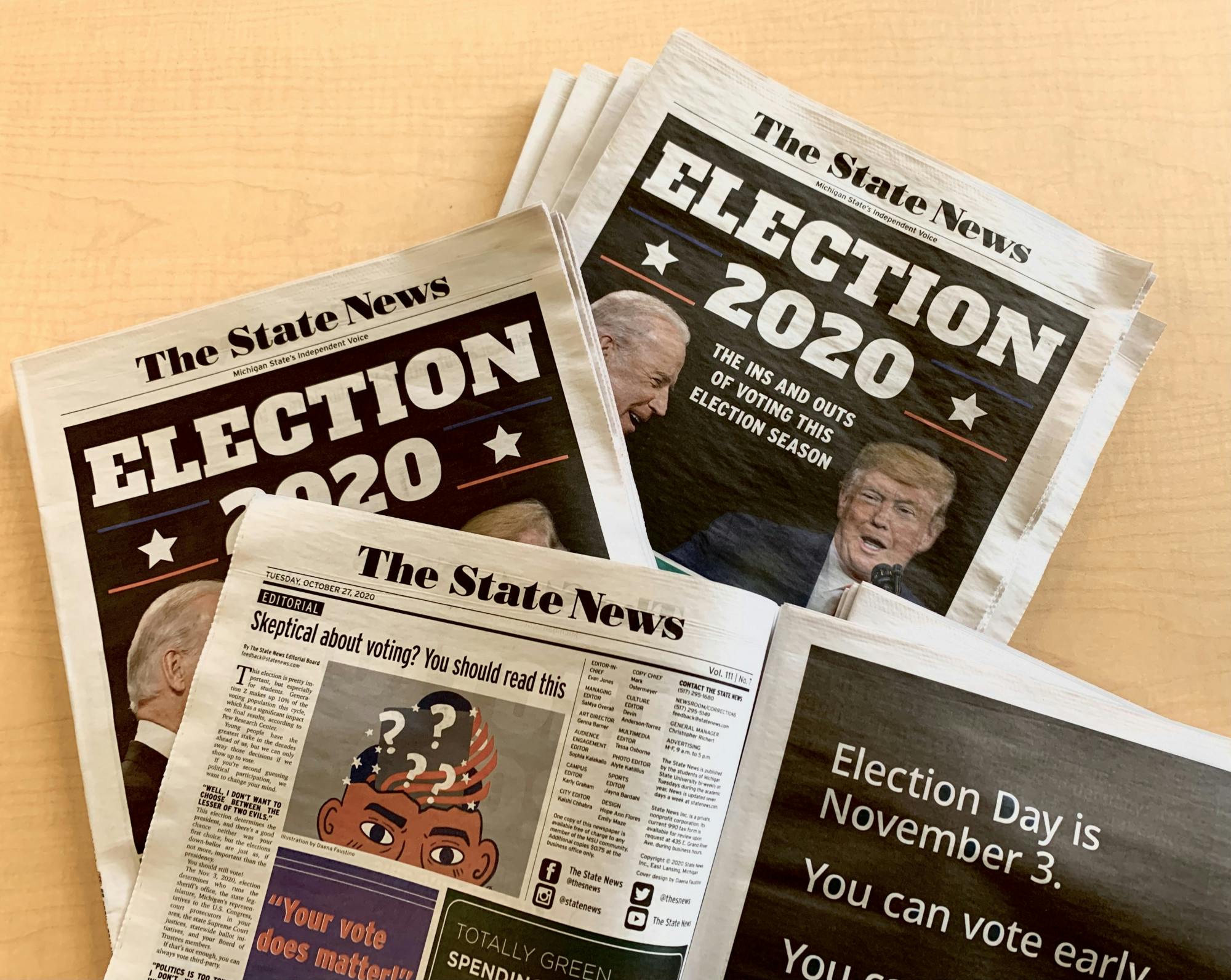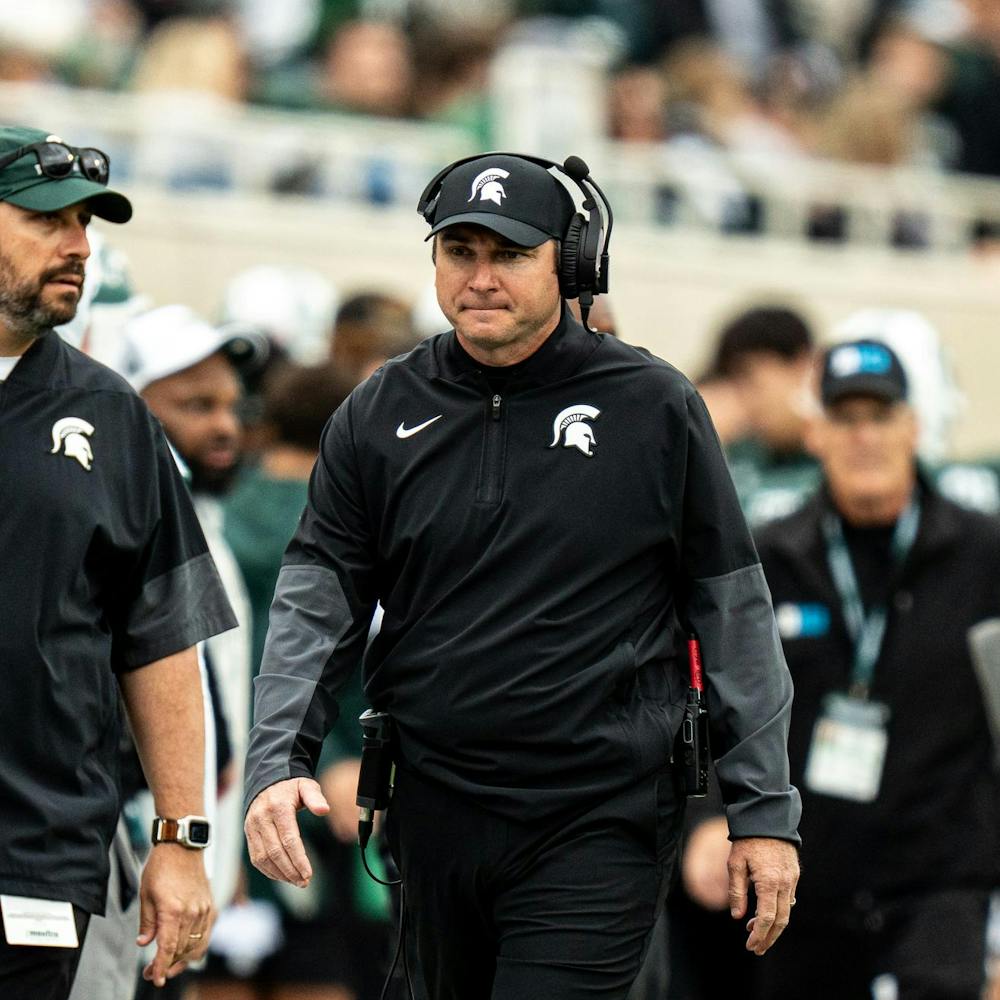Specifically, we want to talk about advertisements.
The State News received a lot of feedback about ads placed by the owners of Harpers Restaurant & Brewpub and Political Plushies USA, a Kickstarter campaign promotion for Trumpangutan using the domain name ReelectDonald.com
Many readers in the community found these ads offensive and irresponsible. While the dozens of you who called and emailed expressed outrage at the ads' content, you were also angry, disappointed, and disgusted with The State News for running them. Why then did we accept these ads?
Before answering, we'd like to clarify a few things:
First, an advertisement — whether for political candidates or a business — expresses the clients' opinion that purchased it. It is not the newspaper's opinion, and its appearance in the paper is not an implied endorsement of its message.
There is a clear separation between our newsroom staff and our advertising staff. They are hired separately by different people.
The newsroom staff, which includes The State News Editorial Board, is not consulted on advertising decisions. Similarly, the advertising staff is not consulted on editorial decisions.
Reporters either pitch stories to write or receive assignments from their editor without influence from outside sources.
It is The State News' policy to label ads on social media with #Ad or #Sponsored or a "paid for" line on the post.
Although opinion columns, letters to the editor, and advertisements are labeled, we understand that it is difficult to differentiate between news and opinion, as well as advertising and editorial content. This is especially true when advertisements are published on social media. There hasn’t been a time in history where people have had to comprehend so much information on a daily basis. It’s overwhelming.
Second, newspapers are free to accept or reject any advertisement for any reason. So, did this ad "slip by," as some have suggested in our defense?
No. These ads were reviewed to ensure they weren't libelous and to see if they met our admittedly subjective standards governing what goes into the paper. For better or worse, we accept responsibility for running these ads. We hope you'll understand why we did, even if you disagree with our decision after seeing it.
One of the most critical roles that newspapers play in our democracy is that of a forum for public debate — to provide, on a local level, the "marketplace of ideas" deemed essential for democracy to flourish. So, when we evaluate ads for appropriateness, we give advertisers the broadest possible latitude to say what they want, the way they want. Why? Because advertisements are where businesses or individuals can directly make their case to readers without editing by the newspaper.
While we do our best to be objective and accurate with our coverage, not surprisingly, readers sometimes feel that our content is inaccurate, inadequate, or unfair.
Were these ads so offensive that they should have been censored? In court, when a judge decides whether the jury should hear a plaintiff's claim, they must look at all the evidence in the light most favorable to the plaintiff, in other words, to give them the benefit of the doubt. That's a fair analogy to how we review ads to see if we should accept them to be placed online or in print.
We spoke to dozens of loyal readers who were deeply offended by these ads and our decision to run them. We underestimated the depth of emotions these advertisements would stir up.
Based on the responses we received, we made the wrong call here.
The advertisements have since been taken down and refunded. The State News Editorial Board, with approval from our general manager, decided that we will not accept advertisements that either:
Support student media!
Please consider donating to The State News and help fund the future of journalism.
Could be viewed as distasteful
Promote potentially irresponsible behavior that could increase the risk of COVID-19 infections throughout the East Lansing community, especially at a time where statewide cases are reaching new heights
While figuring out a good balance between what ads to post and which ads to halt can be difficult.
Other bars and restaurants are open under similar guidelines and Harper’s specifically received clearance from both the Ingham County Health Department and the Michigan Liquor Control Commission — we will do our best to only advertise for locations and experiences that will be safe.
We want to be a source you can trust. We want to publish credible news for students by students. This has been the case since our establishment in 1909.
How we’re reimbursed
First, we do not receive funding from Michigan State University.
We’re a separate non-profit organization, relying on revenue from the following sources
A student-voted subscription tax approved by the MSU Board of Trustees, in effect since 1971, the year we became independent from the university
Advertising and marketing sales, including our SNworks division, which sells a content management platform to other student-run publications
The student tax is refundable in the first two weeks of every semester, and it funds operations specifically pertaining to students, such as student payroll, web hosting fees, marketing, printing and other operating expenses.
Because of this, we aren’t censored by the university and can better serve the MSU community.
This independence comes with a cost. We continue to pay the entire student staff. Plenty of student newsrooms only pay editors and rely on volunteer reporting.
When we pay our student staff, we allow them to commit more time and energy into bringing you the news as opposed to committing more time to a separate income source. Although our journalists have worked primarily remotely since March, we also maintain our newsroom building on East Grand River Avenue and have weathered the costs of COVID-19 — reflected in the decision to cut weekly print publication to biweekly on Tuesdays.
It’s easy to make a scapegoat out of “the media.” What’s more difficult to do is understand its inner workings while running a newsroom as a full-time student with limited resources.
Advertising is necessary to keep our publication afloat, but we don’t want to publish something that might cause harm and damage our credibility in the process. It goes without saying, advertisements neither reflect the official positions of the Editorial Board nor influence our news content.
The State News is the independent student publication that serves Michigan State students first and foremost, and we intend to keep it that way.
The State News Editorial Board is composed of Editor-in-Chief Evan Jones, Managing Editor SaMya Overall, Campus Desk Editor Karly Graham, City Desk Editor Kaishi Chhabra, Culture Desk Editor Devin Anderson-Torrez, Sports Desk Editor Jayna Bardahl, Copy Chief Mark Ostermeyer, Audience Engagement Editor Sophia Kalakailo, Multimedia Manager Tessa Osborne, Photo Editor Alyte Katilius, Staff Rep. Wendy Guzman and Diversity and Inclusion Rep. Di’Amond Moore.
Discussion
Share and discuss “Editorial: The difference between advertisements and editorial content” on social media.







